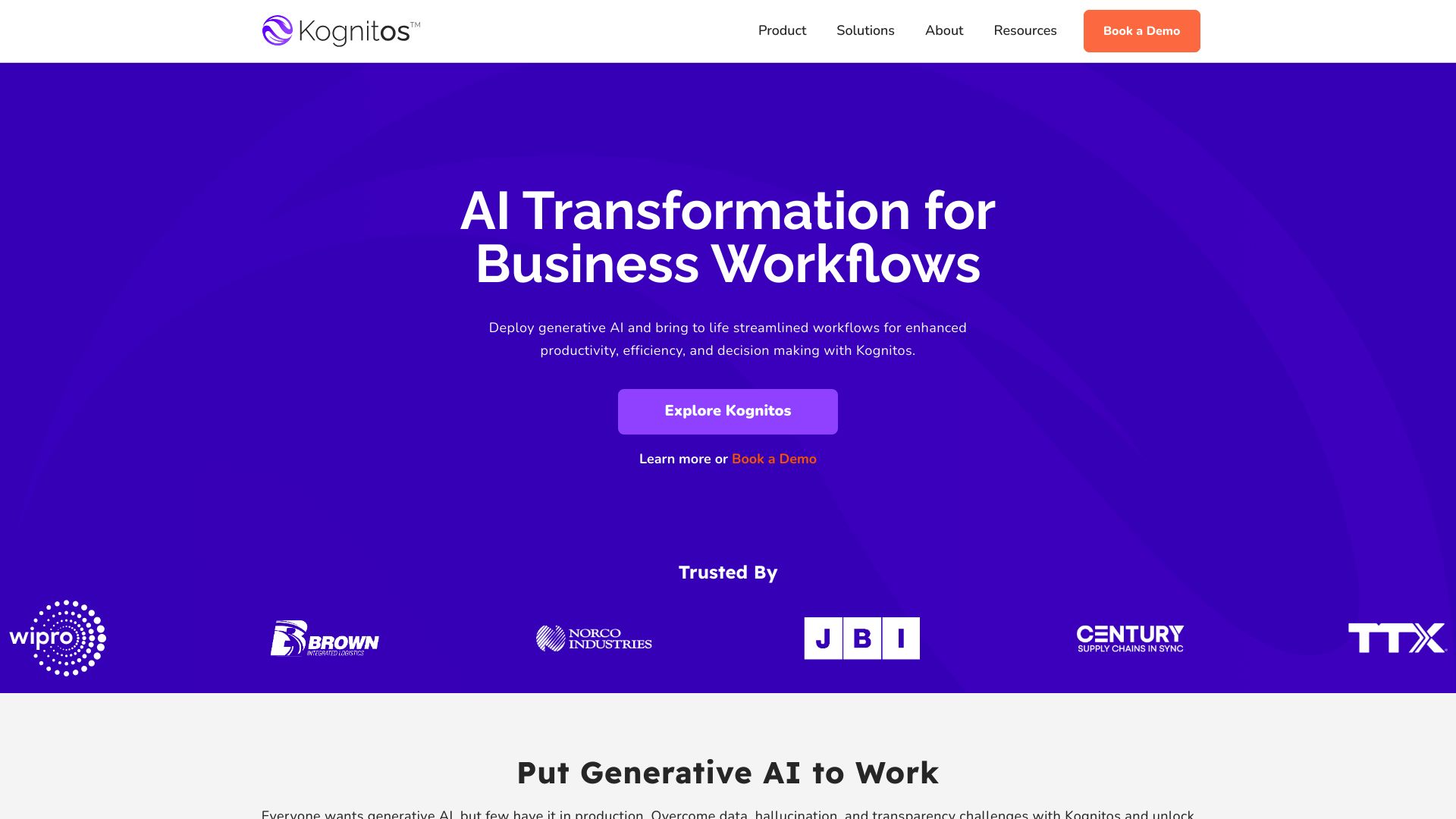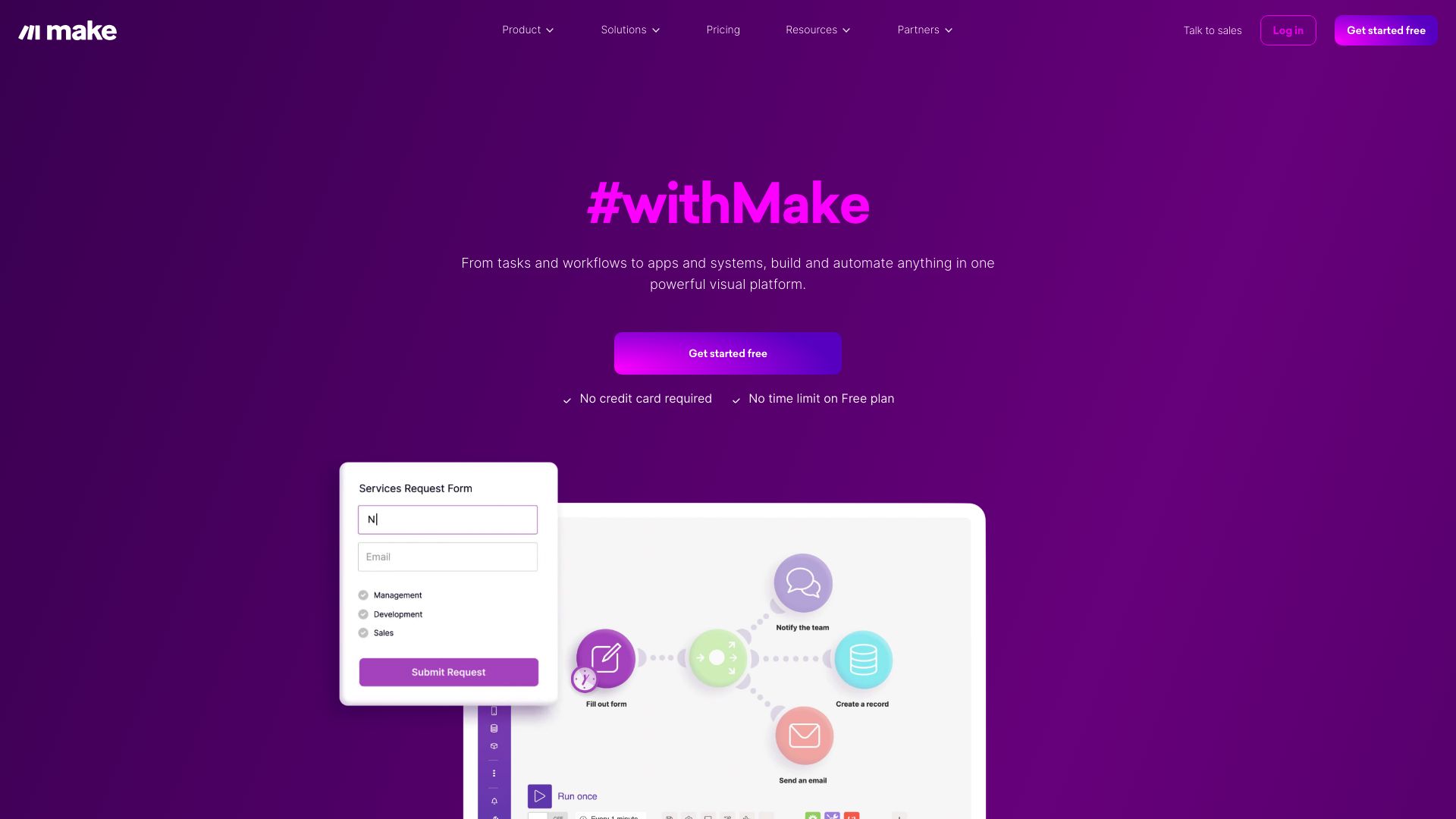Kognitos vs. Make.com: AI-Driven Automation Showdown
AI-powered automation revolutionizes how businesses streamline operations and boost productivity. This comparison explores Kognitos vs. Make.com, and SmythOS—three platforms reshaping the automation landscape. Kognitos leverages natural language processing for intuitive, code-free automation. Make.com offers a visual approach to connecting apps and building workflows.
SmythOS combines these strengths with advanced AI capabilities, providing a comprehensive solution for creating and deploying intelligent agents. We’ll examine each platform’s unique features, integration capabilities, and suitability for various business needs, empowering you to choose the ideal automation tool for your organization.
Kognitos Overview
Kognitos revolutionizes business automation through its innovative AI-powered platform. The software interprets and executes processes written in plain English, eliminating the need for complex coding. This approach democratizes automation, allowing users across various skill levels to streamline operations efficiently.


Kognitos leverages natural language processing and large language models to create intelligent agents capable of handling complex business logic and edge cases. These agents operate autonomously, learning from user interactions and exceptions to continuously improve their performance. The platform excels in document processing, data manipulation, and integration with popular business systems like Salesforce.
Kognitos revolutionizes business automation through its innovative AI-powered platform. The software interprets and executes processes written in plain English, eliminating the need for complex coding.
Unlike traditional robotic process automation (RPA) tools, Kognitos runs entirely in-browser and utilizes stable API-based automations. This approach eliminates the need for bot management, simplifying deployment and maintenance. The platform’s adaptability shines in its ability to handle exceptions by learning from user input, making it highly flexible in managing process variations.
Kognitos prioritizes transparency and accountability. The system maintains a detailed record of all actions and decisions, providing a comprehensive audit trail. This feature ensures explainability in AI-driven processes, a crucial aspect for businesses operating in regulated environments. Additionally, the platform’s collaborative features enable teams to work together effectively, fostering a human-AI partnership that enhances productivity.
The system maintains a detailed record of all actions and decisions, providing a comprehensive audit trail. This feature ensures explainability in AI-driven processes…
While Kognitos offers powerful automation capabilities, it may not suit all use cases. The platform’s focus on natural language automation means it lacks a visual drag-and-drop interface, which some users might prefer. Additionally, there’s no explicit mention of multimodal capabilities or integration with specific AI models like those from Hugging Face, potentially limiting its applicability in certain specialized scenarios.
Make.com Overview
Make.com delivers a powerful visual automation platform for connecting apps and streamlining workflows without code. The intuitive drag-and-drop interface enables users to build complex scenarios linking over 1000 popular services and APIs.
Businesses leverage Make.com to automate repetitive tasks, synchronize data between systems, and create custom integrations. The platform caters to various skill levels, from non-technical users seeking simple automation to developers building sophisticated workflows.
Make.com delivers a powerful visual automation platform for connecting apps and streamlining workflows without code.


Make.com excels at transforming manual processes into efficient automated workflows. Users can schedule scenarios to run on set intervals, manipulate data between apps, and leverage robust logging for debugging. The platform scales from personal projects to enterprise-grade solutions, with collaboration features for team-based development.
Make.com excels at transforming manual processes into efficient automated workflows.
While Make.com offers extensive integration options, it lacks some advanced AI agent capabilities found in dedicated AI platforms. The focus on traditional app integration and workflow automation means users may need to supplement Make.com with other tools for complex AI tasks or natural language processing.
Make.com’s strength lies in its accessibility and broad applicability across industries. The visual approach to automation empowers users to rapidly prototype and deploy integrations, reducing the technical barrier for process optimization. For businesses seeking to enhance productivity through connected systems and automated workflows, Make.com provides a versatile and user-friendly solution.
Make.com’s strength lies in its accessibility and broad applicability across industries.
Feature Comparison
Kognitos and Make.com offer distinct approaches to automation, with key differences in their core capabilities and target use cases. Kognitos leverages natural language processing and AI to interpret and execute processes written in plain English, eliminating the need for complex coding. Make.com, in contrast, provides a visual drag-and-drop interface for connecting apps and building automated workflows without code.
A significant feature gap exists in the AI and natural language processing capabilities. Kognitos excels in this area, utilizing advanced AI to understand and execute complex business logic expressed in natural language. Make.com lacks this level of AI sophistication, focusing instead on traditional app integrations and workflow automation. This difference impacts the ease with which users can create and modify automations, especially for complex, language-dependent tasks.
In terms of security, both platforms offer encryption and authentication features, but Kognitos’ AI-driven approach may provide additional layers of intelligent security and anomaly detection. Make.com’s extensive integration catalogue and visual workflow builder offer broader connectivity options, potentially outperforming Kognitos in scenarios requiring connections to multiple third-party services. However, Kognitos’ ability to adapt and learn from exceptions gives it an edge in handling evolving business processes and edge cases.
Feature Comparison Table
| Kognitos | Make.com | SmythOS | |
|---|---|---|---|
| CORE FEATURES | |||
| AI Agents | ✅ | ❌ | ✅ |
| Hosted Agents (Dev, Production) | ✅ | ❌ | ✅ |
| Environments (Dev, Production) | ✅ | ❌ | ✅ |
| Visual Builder | ❌ | ✅ | ✅ |
| Memory & Context | ✅ | ❌ | ✅ |
| Autonomous Agents | ✅ | ❌ | ✅ |
| Explainability & Transparency | ✅ | ❌ | ✅ |
| Multimodal | ✅ | ❌ | ✅ |
| Problem-Solving Capabilities | ✅ | ❌ | ✅ |
| Multi-Agent Collaboration | ✅ | ❌ | ✅ |
| Human-AI Interaction | ✅ | ❌ | ✅ |
| SECURITY | |||
| Constrained Alignment | ❌ | ❌ | ✅ |
| Data Encryption | ✅ | ❌ | ✅ |
| IP Control | ❌ | ❌ | ✅ |
| COMPONENTS | |||
| Foundation AIs | ✅ | ❌ | ✅ |
| Huggingface AIs | ✅ | ❌ | ✅ |
| Zapier APIs | ❌ | ❌ | ✅ |
| Classifiers | ✅ | ❌ | ✅ |
| Data Lakes | ❌ | ❌ | ✅ |
| DEPLOYMENT OPTIONS (EMBODIMENTS) | |||
| Deploy as API | ✅ | ❌ | ✅ |
| Deploy as Webhook | ❌ | ✅ | ✅ |
| Staging Domains | ✅ | ❌ | ✅ |
| Production Domains | ✅ | ❌ | ✅ |
| Deploy as Site Chat | ❌ | ❌ | ✅ |
| Deploy as GPT | ❌ | ✅ | ✅ |
| DATA LAKE SUPPORT | |||
| Hosted Vector Database | ❌ | ❌ | ✅ |
| Sitemap Crawler | ❌ | ❌ | ✅ |
| YouTube Transcript Crawler | ❌ | ❌ | ✅ |
| URL Crawler | ❌ | ❌ | ✅ |
| PDF Support | ✅ | ❌ | ✅ |
| Word File Support | ✅ | ❌ | ✅ |
| TXT File Support | ✅ | ❌ | ✅ |
Best Alternative to Kognitos and Make.com
SmythOS stands out as the superior alternative to Kognitos and Make.com for AI agent automation. Our platform combines the strengths of both competitors while addressing their limitations, offering a comprehensive solution for businesses seeking to leverage AI technology.
We provide an intuitive drag-and-drop interface that surpasses Make.com’s visual builder, allowing users to create complex AI workflows without coding expertise. Unlike Kognitos’ focus on natural language processing, our platform supports a wider range of AI models and integrations, including popular services like OpenAI, Anthropic, and Hugging Face.
SmythOS stands out as the superior alternative to Kognitos and Make.com for AI agent automation… offering a comprehensive solution for businesses seeking to leverage AI technology.
Our multi-agent collaboration feature sets us apart from both Kognitos and Make.com. We enable teams of AI agents to work together seamlessly on complex tasks, enhancing efficiency and scalability. This capability is particularly valuable for enterprises dealing with intricate business processes that require coordinated AI efforts.
Security and deployment options are areas where we excel. We offer robust data encryption, IP control, and constrained alignment features that surpass both competitors. Our platform allows for flexible deployment as APIs, webhooks, site chats, and even as ChatGPT plugins, providing versatility that neither Kognitos nor Make.com can match.
With SmythOS, users gain access to a hosted vector database, advanced crawling capabilities, and support for various file formats — features absent in both Kognitos and Make.com. These tools empower businesses to harness the full potential of their data, creating more intelligent and adaptable AI agents. By choosing SmythOS, companies can automate a broader range of tasks, improve decision-making processes, and drive innovation across their operations.
Conclusion
Kognitos and Make.com offer powerful automation solutions, each with unique strengths. Kognitos excels in AI-driven natural language processing, enabling users to create complex automations using plain English. This approach democratizes automation, making it accessible to users across various skill levels. Make.com, on the other hand, provides a robust visual platform for connecting apps and streamlining workflows without code, offering extensive integration options and a user-friendly interface.
While both platforms have their merits, SmythOS emerges as the superior choice, combining the best of both worlds and offering additional advanced features. Our platform provides a comprehensive solution for creating and deploying AI agents with unparalleled flexibility and power. SmythOS’s drag-and-drop interface rivals Make.com’s ease of use, while our advanced AI capabilities surpass Kognitos’ natural language processing.
SmythOS stands out with its extensive integration ecosystem, supporting over 300,000 integrations and a wide range of AI models. This versatility allows users to create sophisticated multi-agent systems capable of handling complex tasks across various industries. Our ’Create Once, Deploy Anywhere’ approach ensures that AI agents can be seamlessly integrated into multiple environments, from chatbots and APIs to scheduled tasks and GPT platforms.
Experience the future of AI automation with SmythOS. Create a free SmythOS account today and discover how our platform can revolutionize your workflow. With unlimited agents, a generous free plan, and a 30-day money-back guarantee, there’s no risk in exploring the potential of AI workforce 3.0. Dive into our comprehensive documentation to learn more about our enterprise-ready AI solutions and unleash the power of versatile AI deployment for your business.
Last updated:
Disclaimer: The information presented in this article is for general informational purposes only and is provided as is. While we strive to keep the content up-to-date and accurate, we make no representations or warranties of any kind, express or implied, about the completeness, accuracy, reliability, suitability, or availability of the information contained in this article.
Any reliance you place on such information is strictly at your own risk. We reserve the right to make additions, deletions, or modifications to the contents of this article at any time without prior notice.
In no event will we be liable for any loss or damage including without limitation, indirect or consequential loss or damage, or any loss or damage whatsoever arising from loss of data, profits, or any other loss not specified herein arising out of, or in connection with, the use of this article.
Despite our best efforts, this article may contain oversights, errors, or omissions. If you notice any inaccuracies or have concerns about the content, please report them through our content feedback form. Your input helps us maintain the quality and reliability of our information.
